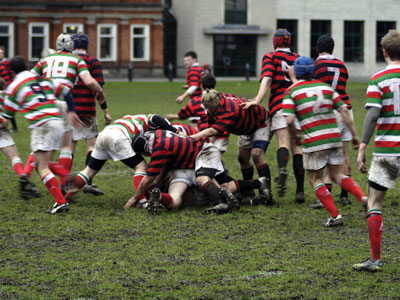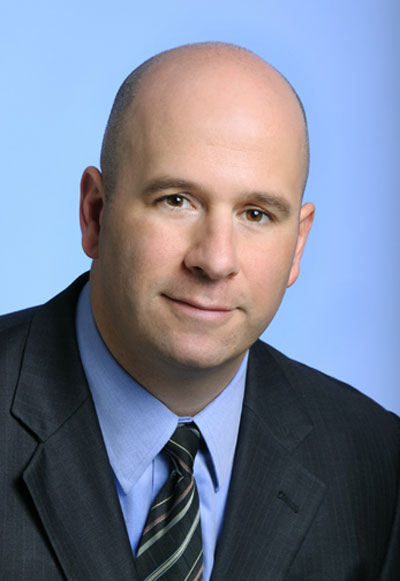
Concussion and Post-concussive Syndrome
By Steven Geanopulos DC DACNB and Wanda Lee McPhee DC
Features Clinical Patient CareThere are few health issues that have received as much recent media
attention as concussion injuries and post-concussive syndrome.
There are few health issues that have received as much recent media attention as concussion injuries and post-concussive syndrome. Professional athletes in many sports, and around the world, appear almost daily in newspapers, in magazines and online in discussions about injuries, return-to-play and long-term issues. These injuries are not limited to professional sports but are inherent to all sport activities. In each of our communities, there are hundreds of young athletes who participate in the same sports and recreational activities as do professional athletes, and they, too, encounter the risk of injury on a daily and weekly basis. Chiropractors – particularly those who focus on sport or pediatric populations – are frequently an integral part of the health-care team in monitoring, assessing and caring for young players recovering from a concussion injury.
 |
|
| Overall, hockey and rugby have the highest incidence of concussion. Advertisement
|
At St. Margaret’s Bay Chiropractic Centre in Nova Scotia, we have created a special niche in screening and subsequently co-treating young athletes at risk of or following concussion injuries. With our own children involved in hockey and ringette as well as a practice focused on children and families, we have been consistently involved in helping children already in our practice with concussion recovery. This has transformed into an opportunity to serve the greater community on a larger scale.
’Keep your Head in the Game’ Screening Program
We developed “Keep Your Head in the Game” concussion screening protocols based on the most current science of the day combined with the practicality of performing screenings in arenas, fields and community centres. To date we have screened hundreds of young athletes in our community, providing them with baseline records that have proven valuable when later injuries occur and they present to the local pediatric hospital. Chiropractic offices in the United States, Canada and Australia have used our protocols to develop these programs with teams in their areas as well. The consistent baseline and post-injury testing used allows for a common language among all professionals on the health-care team and provides co-ordination of diagnosis, treatment and followup. Working together with emergency room physicians, family doctors, pediatric neurologists and chiropractic neurology diplomates has been a learning experience for us, and for them as well, that results in optimal care of these children and adolescents.
Each year more than 300,000 sport-related mild-to-moderate traumatic brain injuries occur in the United States.1 Overall, hockey and rugby have the highest incidence of concussion, and soccer has one of the lowest incidence rates.2 Male boxers and female taekwondo participants have the highest concussion frequency in recreational activities.2 Unfortunately, these statistics are most likely lower than the true incidence as many athletes still do not recognize or report concussion injuries.2,3 Equally unfortunate is that parents do not fully understand the significance of a diagnosis of concussion. Several studies have shown that when given a diagnosis of concussion, families are less likely to consider it a brain injury than a temporary and/or less serious condition.3 Parents, and even some health-care providers, may use the term to imply a transient condition with no significant health consequences.3 The reality is that concussion is a mild traumatic brain injury and although many cases resolve fully,2 there are potential consequences that parents and clinicians must take seriously.4,5
What is a concussion?
Definitions for concussion are not always consistent in the literature but recent attention and discussion is helping to create better agreement on what constitutes a concussion injury. The Canadian Paediatric Society describes concussion as “a complex pathophysiological process that affects the brain, induced by traumatic biomechanical forces resulting in the rapid onset of short-lived impairment of neurologic function that resolves spontaneously. Concussion may be sustained by a direct blow to the head, face, or neck or by a blow to somewhere else on the body that transmits an impulsive force to the head. Most concussions do not cause a LOC [loss of consciousness] or cause only a transient (i.e., lasting seconds) LOC.”6
Concussion diagnosis and treatment is never easy. Despite great advancements in standardizing and documenting testing and symptoms, young athletes are at particular risk for misdiagnosis and potentially serious long-term effects. Standard testing such as Sport Concussion Assessment Tool (SCAT) and SCAT2 are excellent examination tools for adults as we can safely assume that a healthy, normal adult can perform the tests without significant challenge, but that is not the case for child and adolescent patients!
Concussion is generally diagnosed using a thorough history and symptom profile and measured in severity with various neurological and neuro-behavioural activities. Most sport participants who sustain a concussive injury do not lose consciousness – and loss of consciousness in isolation is a relatively weak predictor of neuro-behavioural outcomes.2 For those of you who would like further reading, one of the most comprehensive sources is the consensus document generated from the Third International Conference on Concussion in Sport.7
Children and adolescents are still developing the neurological integrity that tests of memory, balance and concentration seek to measure. Even within the same age group, there can be significant variation in test scores among healthy patients, which creates a diagnostic challenge for the clinician testing children and adolescents post-injury. How much has been lost or changed in the scores if we don’t know what the scores were prior to injury? Relying on post-injury test scores only, there is no doubt that more than half of the hundreds of athletes we have tested would be unable to return to play, as they were originally unable to perform the testing activities at an adequate level, even without a concussion injury!
In developing a screening protocol for local athletes, and in screening hundreds of athletes ages eight to 17, the need for pre-injury baseline testing has become apparent. Knowing the pre-incident condition is crucial for making appropriate diagnosis of concussion, ranking the severity of the injury, determining treatment protocols, measuring recovery rates and determining back-to-play status.8 There is substantial variation in responses to concussion injury.2 Most experts note that the initial grading of concussion is less relevant to recovery post-concussion than systematic tracking of each athlete’s recovery over time.2 As a parent, knowing that we can be as specific and measured as possible with a challenging entity like concussion injury or post-concussive syndrome allows for: better decision-making and understanding of when a child athlete should be removed from the game; better recognition of when it is unsafe to return to play; and the reassurance that returning to the game is appropriate.
Reasons people respond so differently to care after a concussion
It seems that, while one athlete may have a concussion and recover without prolonged symptoms and return to normal activities, others may suffer chronic headaches, concentration problems, difficulty with focus and attention, depression, etc., for many months or even years. Sometimes the severity of the impact does not seem to match the duration or severity of the injury.
What could explain such differences in outcome? The answer lies in:
1) Understanding the neuro-chemistry of concussion.
A concussion is a mechanical insult that alters chemistry, resulting in a chemical insult.
It is difficult for most clinicians to appreciate this because after structural damage has been ruled out by imaging like MRI and CT, the only mainstream assessment is neuro-psychological. Abnormal findings are then labelled psychiatric, ignoring the mechanical cause of the condition. These findings are then either not treated – and the patient waits for spontaneous resolution – or symptoms are treated with medication that does nothing to address the underlying problem.
2) Chemical insults in the body are handled by the immune system.
The immune response is individualized and is determined by genetics, previous health history, diet and nutrition pre- and post- injury, among other predisposing factors.
At 29 years of age, professional soccer player Ross Paule states, “The symptoms are at their worst when I’m tired and sick. It’s like the concussions broke down my immune system. It’s a serious thing.”
3) Mechanical and chemical insult to the brain alter the function of pathways in the nervous system.
The pathways that are affected are determined by the location of the injury and the course the inflammation takes after the injury. We know that the most obvious pathways affected, or perhaps the ones we have identified, involve the balance (vestibular) system and the extraocular (eye movement) systems. In these cases we have to remember that we are not rehabilitating injured muscle, but we are rehabilitating injured brain and neuronal tissue.
Failing to understand this concept will dramatically reduce the chances of a favourable outcome. The sports injury world clearly understands the healing process of injured muscle tissue, ligaments and tendons. We know precisely how long these tissues need to repair before we begin rehab procedures. For example, when I had my anterior cruciate ligament (ACL) reconstruction surgery, the doctors and therapists involved had a clear understanding of the process and the capacity the injured tissue had each week post- surgery for recovery of function and improvement of strength and endurance.
It is precisely a lack of this type of understanding of injured neuronal tissue, and how to determine the differences between different people with different biochemical and immune system makeup, that we have such poor outcomes for concussion for some and such good outcomes for others. We are depending on luck.
4)The gut / brain connection.
This last reason for the differences we have to consider in post-concussion care versus other athletic therapy or rehabiliation is worthy of its own article. Studies have shown leaky gut syndrome six hours post-concussion. This causes a cascade of events that result in a chronic heightened immune response that can impact long-term brain function.
The role of chiropractors
Chiropractors are key members of appropriate team management in concussion injuries. The etiology of concussion is traumatic and as such must be differentiated or managed concurrently with other effects of the trauma such as whiplash, subluxation, neck strain, facet syndromes and muscle spasm. Chiropractors are uniquely capable, and some of the best-trained professionals, to deal with the multiple facets of a concussion injury and should be involved in the health team from prevention to return to play.
Prevention, pre-injury status, post-injury assessment, diagnosis, treatment and followup are all key components in considering the big picture of concussions for our young athletes, and there is a role for chiropractic in all of these areas. Our training and education in neurology combined with our specialized knowledge and experience in musculoskeletal function, nutrition and exercise are powerful tools to make a difference in our communities by keeping our children safe and active in sports!
REFERENCES
(1)
Koh JO,
Cassidy JD,
Watkinson EJ.
Incidence of concussion in contact sports: a systematic review of the evidence.
Faculty of Physical Education and Recreation, University
of Alberta, Edmonton, Canada.
(2)
Michael W.
Kirkwood, PhD, Keith Owen Yeates,
PhD, Pamela E. Wilson,
MD. Pediatric Sport-Related Concussion: A Review of the Clinical Management of
an Oft-Neglected Population. PEDIATRICS Vol. 117 No. 4 April 1, 2006 pp. 1359
–1371.
(3)
McCrory P.
Pre-participation assessment for head injury. Clin J Sport Med. 2004
May;14(3):139-44.
(4)
Carol
A. DeMatteo, Steven E. Hanna, William J. Mahoney, Robert D. Hollenberg, Louise
A. Scott, Mary C. Law, Anne Newman,
Chia-Yu A. Lin and Liqin Xu. ''My Child
Doesn't Have a Brain Injury, He Only Has a Concussion.'' Pediatrics
2010;125;327; originally published
online January 18, 2010; DOI: 10.1542/peds.2008-2720.
(5)
Canadian Paediatric Society. Identification and management of
children with sport-related concussion. Paediatr Child Health.
2006;11(7):420–428.
(6)
Keith
Owen Yeates, PhD; Eloise Kaizar, PhD; Jerome Rusin, MD; Barbara Bangert, MD;
Ann Dietrich, MD; Kathryn Nuss, MD; Martha Wright, MD; H. Gerry Taylor,
PhD. Reliable Change in Postconcussive
Symptoms and Its Functional Consequences Among Children With Mild Traumatic
Brain Injury. Arch Pediatr Adolesc Med. Published online March 5, 2012.
doi:10.1001/archpediatrics.2011.1082.
(7)
Shanley Mangeot
Kira Armstrong
Andrew N. Colvin
Keith Owen Yeates
H. Gerry Taylor. Long-Term Executive Function Deficits in
Children With Traumatic Brain Injuries: Assessment Using the Behavior Rating Inventory
of Executive Function (BRIEF); Child Neuropsychology;Volume 8,
Issue 4, 2002 pages
271-284
(8)
McCrory
P, Meeuwisse W, Johnston K, et al. Consensus statement on concussion in sport,
3rd International Conference on Concussion in Sport, held in Zurich, November 2008. Clin J Sport Med.
2009;19:185-200.
 |
Dr. Steven Geanopulos received his BSc in human anatomy and DC from Parker University in Dallas,
Texas. He has attained his postgraduate education in neurology and was awarded Diplomate status from the American Chiropractic Neurology Board. He is currently enrolled in a postdoctoral course in neurochemistry at Life University through the Carrick Institute. In addition to postgraduate work in neurology Dr. Geanopulos has pursued an education in functional medicine. Dr. Geanopulous practises in mid-town Manhattan in New York City.

|
Dr. Wanda Lee MacPhee graduated from CMCC and has been in chiropractic practice in Nova Scotia since 1994. She has been registrar, chair of the board and association president in Nova Scotia and served as president of the CFCREAB. She is a current member of the CPG Task Force. In 2000, Dr. MacPhee was honoured as Chiropractor of the Year in Nova Scotia and received the CCA Award of Merit. She currently practises part time with her husband, Dr. Andrew Kleinknecht.
Print this page